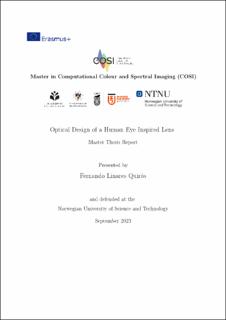| dc.description.abstract | Nature provides one of the most complex and stunning imaging devices found nowadays. The human eye has been studied over centuries and the research community is still trying to totally understand it. With the main interest put in the medical field, numerous anatomical models have been proposed trying to replicate this human organ and psychophysical models to understand the image processing carried out inside the brain. In this thesis, another attempt to understand this device is conducted with the aim to replicate as closely as possible the imaging capabilities of the eye while respecting its form-factor characteristics. To develop the design, the use of the optical modelling software CODE V is used, where the different eye constraints are established. Using as a starting point a monochromatic spherical design, six different setups are proposed, showing that the number of optical surfaces employed can be considerably reduced by using aspherical/conic surfaces. The implementation of an achromatic doublet will also increase the performance considerably. The implementation of a curved sensor mimicking the retina does not improve significantly the results obtained and there is a trade-off between imaging capabilities and optical aberrations. | |
